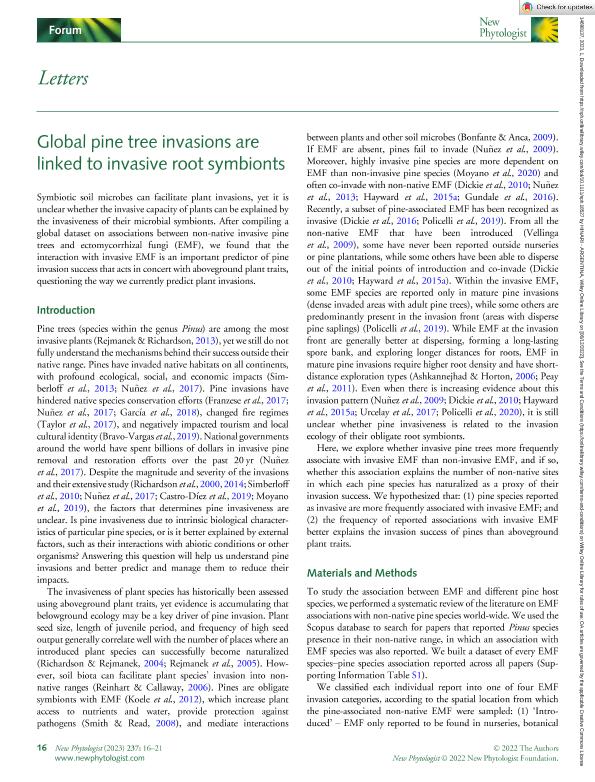Artículo
Global pine tree invasions are linked to invasive root symbionts
Policelli, Nahuel ; Hoeksema, Jason D.; Moyano, Jaime
; Hoeksema, Jason D.; Moyano, Jaime ; Vilgalys, Rytas; Vivelo, Sasha; Bhatnagar, Jennifer M.
; Vilgalys, Rytas; Vivelo, Sasha; Bhatnagar, Jennifer M.
 ; Hoeksema, Jason D.; Moyano, Jaime
; Hoeksema, Jason D.; Moyano, Jaime ; Vilgalys, Rytas; Vivelo, Sasha; Bhatnagar, Jennifer M.
; Vilgalys, Rytas; Vivelo, Sasha; Bhatnagar, Jennifer M.
Fecha de publicación:
10/2022
Editorial:
Wiley Blackwell Publishing, Inc
Revista:
New Phytologist
ISSN:
0028-646X
Idioma:
Inglés
Tipo de recurso:
Artículo publicado
Clasificación temática:
Resumen
Symbiotic soil microbes can facilitate plant invasions, yet it is unclear whether the invasive capacity of plants can be explained by the invasiveness of their microbial symbionts. We compiled a global database of one of the most widespread invasive non-native species on Earth ? pine trees and their major fungal symbionts, ectomycorrhizal fungi (EMF) ? and tested the hypothesis that the associations with invasive EMF increases the invasion success of pines. We found that successful pine species invasions are better explained by their association with invasive EMF than by aboveground plant traits that are typically used to explain plant invasiveness. Late-successional invasive EMF were most closely related to pine invasion success, implying that this subset of introduced EMF species might be key to sustain the invasion of their hosts. Our results suggest that the interaction with invasive microbial symbionts is an important predictor of plant invasion success.
Archivos asociados
Licencia
Identificadores
Colecciones
Articulos(INIBIOMA)
Articulos de INST. DE INVEST.EN BIODIVERSIDAD Y MEDIOAMBIENTE
Articulos de INST. DE INVEST.EN BIODIVERSIDAD Y MEDIOAMBIENTE
Citación
Policelli, Nahuel; Hoeksema, Jason D.; Moyano, Jaime; Vilgalys, Rytas; Vivelo, Sasha; et al.; Global pine tree invasions are linked to invasive root symbionts; Wiley Blackwell Publishing, Inc; New Phytologist; 237; 1; 10-2022; 16-21
Compartir
Altmétricas



